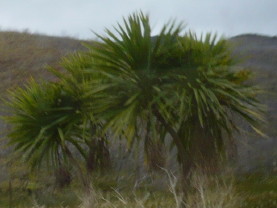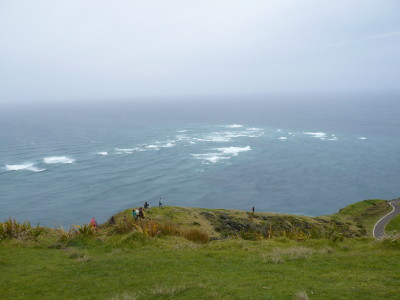
So today I have had a long coach tour trip around the Far North – the spit of land that juts north-west into the Tasman Sea from the top of North Island. It has been a long day, but there have been some notable highlights. The view from my room at the Copthorne in the early morning was a good start, although the jetlag is still robbing me of anything more than a precious three to four hours of good sleep.

The tour guide, a Maori from the Far North himself, and our coach driver, is a fabulous character, and once he has collected the nine of us he has on his tour today, he sings to us all a traditional greeting song, across the tannoy, on his headset mic, as he drives the great coach up the narrow roads. It is a fine start to the day, and we all applaud. He tells us many tales, during the day, and I hear again the story of Kupe and his grandson, of the seven tribes who arrived in seven great Wakas (war canoe) – and how the name of each Waka became the name of the tribe. There was even the story of how Captain Cook saw the Maori boiling up the leaves of a particular tree for medicinal purposes, but thought it would make a great beverage; so he called it the tea-tree.


Perhaps the main theme of the day, though, is the Kauri tree. The Kauri self-prunes as it grows, and grows firm and tall, making it prized the world over for ships masts, plantation house beams, and the like. Stands of Kaori used to cover the whole of the Far North, and on down 200km south of Auckland, until the European settlers arrived, and within a 100 years chopped the lot down and exported it all over the world. Only three pockets of it remain, one of which, Puketi, we visited today, and walked through, on boardwalks not dissimilar to the Lost Gardens of Heligan in Cornwall, excepting of course that here the trees average between 500 and 1000 years old.
One of the day’s stops was the Ancient Kaori Kingdom shop. Much of the land up here is swamp – including acres of protected mangrove – and a thriving business has grown up finding, digging up and recycling what is called Swamp Kaori. Most of it is some 45,000 years old, not very far beneath the surface, perfectly preserved, and excellent for everything from furniture to kitchen utensils etc etc. Of course I have bought a swamp kaori bowl, which will grace my table and serve well for fruit.

Then of course there was 90 mile beach – actually 64 miles long, but it took three days for the traders to trudge it, and they were used to covering 30 miles a day. We drove up this, in the coach, at 100kmph, which was exhilarating and occasionally unnerving, toward the very top of the Far North. About two thirds of the way up, just out into the sea, is an island with a hole in it – like a needle’s eye, and it is here that Maui, one of the greatest of the Maori mythological heroes, fished out the North Island from the sea, from his great Waka, the South Island.

We stopped briefly, just past here, at a bluff where some long forgotten volcano had belched rock into the sea, and then turned inland up one of the many fresh water riverbeds into the dunes. Awaiting us here was quite an experience!  The dunes are huge, glassy, barren, and excellent for surfing down. It is actually called Sand Boarding, and two of us, with the driver, had a go. It was really quite exhilarating and woke me from the stupour the long morning drive had been lulling me into.
The dunes are huge, glassy, barren, and excellent for surfing down. It is actually called Sand Boarding, and two of us, with the driver, had a go. It was really quite exhilarating and woke me from the stupour the long morning drive had been lulling me into.
This was good, because not far from the sand dunes, we made finally for the uttermost tip of the land. Here, the second song of the day introduced us to the place where the ancestors are near. Here, at Cape Reinga, the souls of the Maori dead depart Aeoteoroa for the North West, and head off up to Hawaiiki, the land of the ancestors. It is a very spiritual and sacred spot, where the Pacific Ocean and the Tasman Sea meet in confusion and conflict, splashing every which way at the apex of the Far North. I was very taken with this spot, and stood at the apex of the conical hill overlooking the clashing waves, and faced East, South, West and North, across the Pacific, down the length of New Zealand, out over the Australia, Indonesia and the great expanse of the African and Eurasian continents, and up their eastern coast to China and Japan. It is a breathtaking place from which to look around the world.

